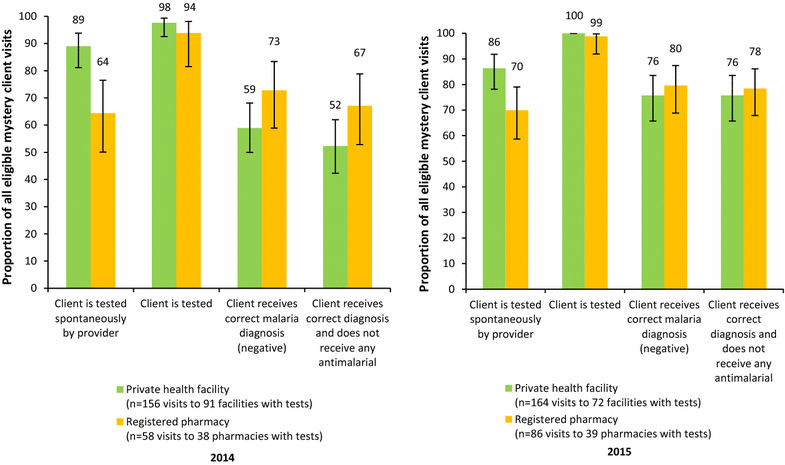Fever case management at private health facilities and private pharmacies on the Kenyan coast: analysis of data from two rounds of client exit interviews and mystery client visits
- PMID: 29534750
- PMCID: PMC5850910
- DOI: 10.1186/s12936-018-2267-8
Fever case management at private health facilities and private pharmacies on the Kenyan coast: analysis of data from two rounds of client exit interviews and mystery client visits
Abstract
Background: Private sector availability and use of malaria rapid diagnostic tests (RDTs) lags behind the public sector in Kenya. Increasing channels through which quality malaria diagnostic services are available can improve access to testing and help meet the target of universal diagnostic testing. Registered pharmacies are currently not permitted to perform blood tests, and evidence of whether malaria RDTs can be used by non-laboratory private providers in line with the national malaria control guidelines is required to inform ongoing policy discussions in Kenya.
Methods: Two rounds of descriptive cross-sectional exit interviews and mystery client surveys were conducted at private health facilities and registered pharmacies in 2014 and 2015, 6 and 18 months into a multi-country project to prime the private sector market for the introduction of RDTs. Data were collected on reported RDT use, medicines received and prescribed, and case management of malaria test-negative mystery clients. Analysis compared outcomes at facilities and pharmacies independently for the two survey rounds.
Results: Across two rounds, 534 and 633 clients (including patients) from 130 and 120 outlets were interviewed, and 214 and 250 mystery client visits were completed. Reported testing by any malaria diagnostic test was higher in private health facilities than registered pharmacies in both rounds (2014: 85.6% vs. 60.8%, p < 0.001; 2015: 85.3% vs. 56.3%, p < 0.001). In registered pharmacies, testing by RDT was 52.1% in 2014 and 56.3% in 2015. At least 75% of test-positive patients received artemisinin-based combination therapy (ACT) in both rounds, with no significant difference between outlet types in either round. Provision of any anti-malarial for test-negative patients ranged from 0 to 13.9% across outlet types and rounds. In 2015, mystery clients received the correct (negative) diagnosis and did not receive an anti-malarial in 75.5% of visits to private health facilities and in 78.4% of visits to registered pharmacies.
Conclusions: Non-laboratory staff working in registered pharmacies in Kenya can follow national guidelines for diagnosis with RDTs when provided with the same level of training and supervision as private health facility staff. Performance and compliance to treatment recommendations are comparable to diagnostic testing outcomes recorded in private health facilities.
Keywords: Case management; Diagnosis; Malaria; Private sector; Rapid diagnostic test; Registered pharmacy.
Figures

References
-
- WHO . Guidelines for the treatment of malaria. 2. Geneva: World Health Organization; 2010. - PubMed
-
- WHO . Global technical strategy for malaria 2016–2030. Geneva: World Health Organization; 2015.
-
- National Malaria Control Programme, Kenya Ministry of Health . Kenya malaria strategy 2009–2018 (revised 2014) Nairobi: NMCP; 2014.
MeSH terms
Substances
LinkOut - more resources
Full Text Sources
Other Literature Sources
Medical

